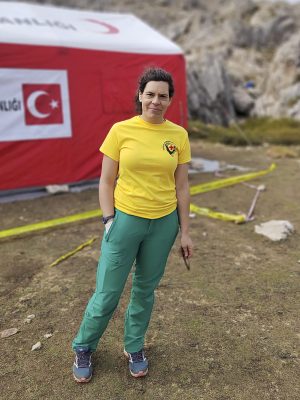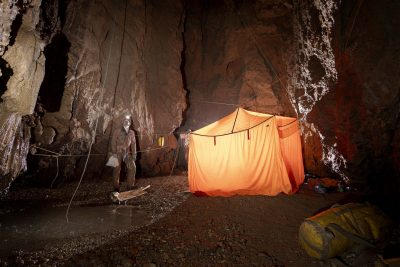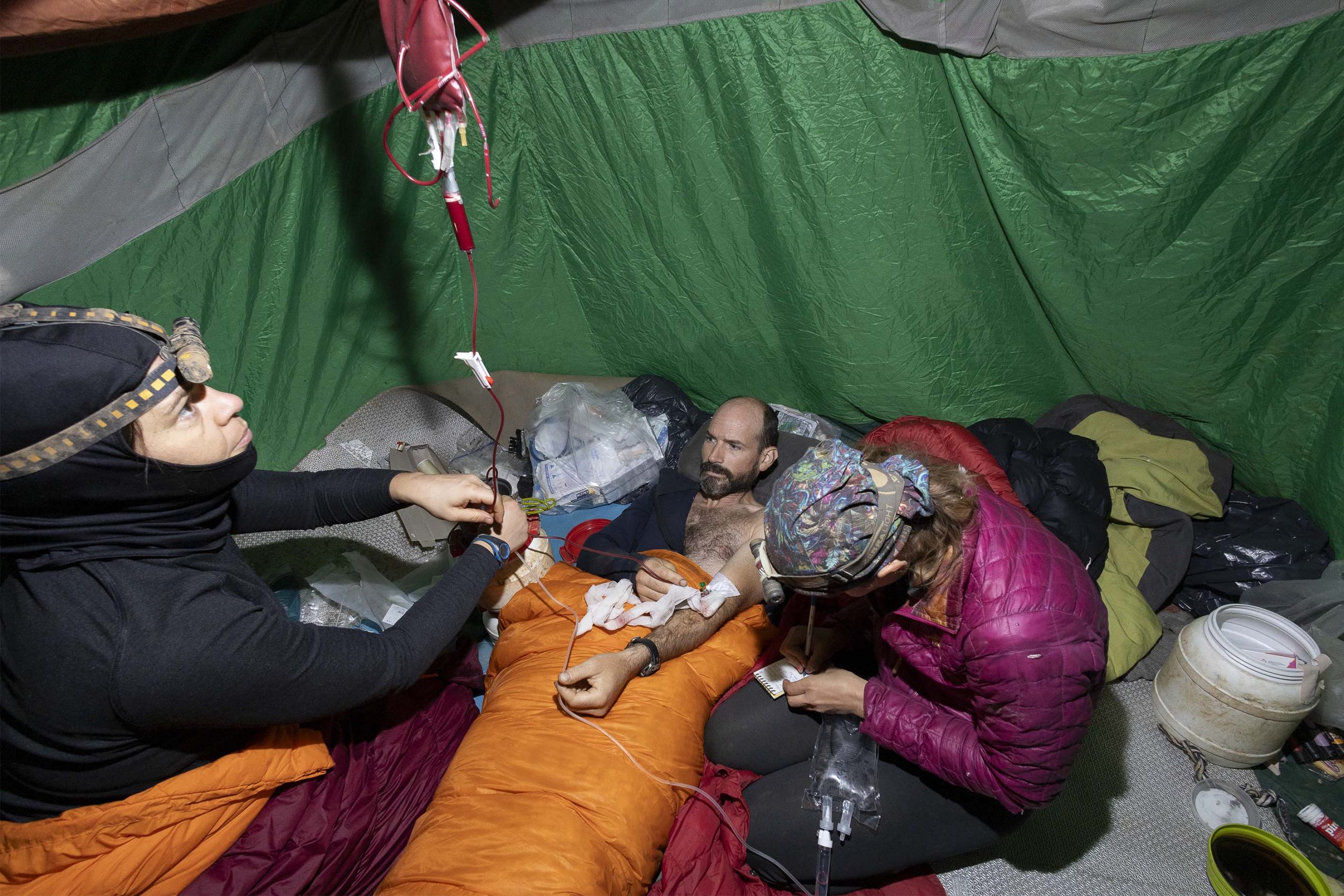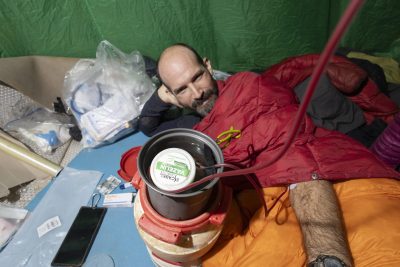“I had to improvise, but luckily I was able to rely on the knowledge I acquired during my general medical training about the use of basic instruments and how to diagnose and treat patients with internal medicine problems without the usual diagnostic tools, based almost only on physical examinations,” said Dr. Zsófia Zádor, Volunteer Doctor of the Hungarian Cave Rescue Service, with whose help it was possible to stabilize the condition of American Speleologist Mark Dickey, who got trapped in the Morca Cave of the Taurus Mountains in southern Turkey. As a result of her intervention, it was possible to rescue the scientist from the camp located more than a thousand meters deep. This has been the deepest successful cave rescue operation ever.
The anesthesiologist and intensive care specialist currently working at the Balassagyarmat hospital started caving during her years at Semmelweis University. As her caving experience accumulated, it became a way of life for her, and new expedition opportunities opened up. At the university, she was initially interested in cardiology, and she conducted her Hungarian student research study called TDK at the Városmajor Heart and Vascular Center exploring newer biomarkers of chronic heart failure with the help of large animal model experiments. Later, her interest turned to anesthesiology and intensive therapy, partly because of the manual therapy experience she gained during her TDK, and partly because these fields are highly interdisciplinary. She completed her medical training in Szekszárd and Pécs, then worked at the Péterffy Sándor Street Hospital in Budapest before taking her current position.

Doctors are highly needed in cave rescue, although there is no prescribed medical qualification or treatment criteria for this – usually the range of necessary equipment is adjusted to the given case, but it is also important for the doctor to have experience as a caver. The Hungarian Cave Rescue Service is special because, among other things, their doctors are also cavers, and this way unique expertise is available when a rescue is needed, said Dr. Zsófia Zádor. She also added many Hungarian doctors go caving in their spare time. The members of the volunteer service hold larger and several smaller rescue exercises twice a year. When there is an emergency case, they are called on and go to participate in the rescue. The last mission was no different. On September 3, she was informed by a colleague that a speleologist from the US had become ill more than a thousand meters deep in southern Turkey and needed help due to internal bleeding. Already that evening, she found herself on her way to Turkey after it turned out that in all of Europe only the Hungarian cave rescuers had the necessary medical experience as well as the experience to descend to a depth of a thousand meters.
“In the beginning, the biggest difficulty for me was the lack of information, since upon arrival there was little to know about the patient’s condition, i.e. how much blood he had lost up to that point. Moreover, the fact that I could not gain information about what medicines would be needed also caused difficulty later. In addition, at the beginning, we were able to take only minimal medical equipment with us. I only had a pulse oximeter, a thermometer and a phonendoscope, so when I started providing care, I had to mostly rely on the signs that could be discerned from the physical examinations while determining how anemic he was,” explained Dr. Zsófia Zádor.
Upon the team’s arrival, it turned out that the patient was in a serious, life-threatening condition, and it was necessary to immediately start protecting his stomach with high-dose medication, and later a blood transfusion was also required. In this case, the depth itself was not a challenge, furthermore, there were no physiological changes to deal with, and fortunately, according to the specialist, the air quality in this cave was also sufficient.

“I suspected a stomach ulcer right from the beginning and started the treatment accordingly, and later, after the successful rescue, the hospital examination confirmed the diagnosis. This is a relatively banal, treatable disease, it just hit the patient in the wrong place,” commented Dr. Zsófia Zádor. Later, an ECG and pressure monitor as well as the active infusion heater arrived, and if necessary, an external pacemaker and defibrillator would have been available too. These were brought down by fellow rescuers commuting between the depth camp used to care for the patient and the surface.

Since the medical team was alerted because of a bleeding problem in the digestive system, human blood derivatives were also needed, but due to legal reasons, these could only be obtained from Turkey, with the assistance of the Red Crescent. Fortunately, the temperature was constant (between 4-6 degrees Celsius) in the rudimentary camp, which was established next to the intensive therapy tent set up by the members of the expedition and the Hungarian rescue team arriving in the first wave. Therefore, they did not have to worry about the cooling of food and blood derivatives as the temperature was just right for storing them. It took almost a day to travel between the surface and the camp. According to Dr. Zsófia Zádor, it was relatively easy to descend the blood derivatives until the depth of 300 meters, and then the cave itself took care of proper storage until they reached the camp.
 However, the temperature caused challenges in patient care. On the one hand, it was necessary to ensure that the patient was kept warm, and on the other hand, the blood derivatives also had to be heated before use. “At first, we made it possible to use the infusion set with my own body heat in my sleeping bag, and later with the use of heated water. Then the active infusion heater and a perfusor arrived, which helped with continuous infusion fluid replacement, and from then I could rely on not only the oral and intravenous administration of the drug,” Dr. Zsófia Zádor recalled the circumstances of the rescue. As she said, blood derivatives are also heated in the hospital before use, but in the cave it was much more difficult to get hot water of the right temperature for this.
However, the temperature caused challenges in patient care. On the one hand, it was necessary to ensure that the patient was kept warm, and on the other hand, the blood derivatives also had to be heated before use. “At first, we made it possible to use the infusion set with my own body heat in my sleeping bag, and later with the use of heated water. Then the active infusion heater and a perfusor arrived, which helped with continuous infusion fluid replacement, and from then I could rely on not only the oral and intravenous administration of the drug,” Dr. Zsófia Zádor recalled the circumstances of the rescue. As she said, blood derivatives are also heated in the hospital before use, but in the cave it was much more difficult to get hot water of the right temperature for this.
Due to the conditions in the intensive care tent, it was also a serious challenge to provide hygiene, especially during blood transfusions, although they tried to disinfect the affected area as often and thoroughly as possible in addition to using rubber gloves. After stabilizing the patient’s condition, they tried to manage the treatment in such a way that the interventions were as minimally invasive as possible in order to avoid infections, added Dr. Zsófia Zádor, who stayed by the patient’s side for several days all around the clock. In addition to the limited instrumental diagnostic background, she had to constantly monitor whether there were any indirect signs of possible complications of the blood transfusion, as well as whether she dosed the anticoagulants correctly, because otherwise thrombosis could have occurred.
After the patient’s condition was stabilized, there was a chance he might leave the cave without support. In the end, however, this idea was abandoned, and after two days of strenuous work, Mark Dickey was elevated to the surface on a stretcher from the Morca Cave with the help of the rope systems that had been built several days earlier. The Hungarian medical team spent seven days in the depths, and since they were able to go up earlier thanks to the Italian relay partners, they waited on the surface for the injured to arrive. After that, the American caver was taken to hospital, and the rescue teams started packing and dismantling the cableways built for stretcher transport and they also began organizing their trip home. They arrived in Hungary at dawn on Friday.
Melinda Kiss
Translation: Mária Sánta
Photo: Hungarian Cave Rescue Service


